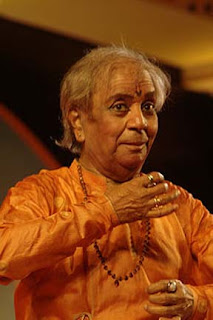Birju Maharaj: The doyen of Kathak
He was born in 1937 to a family of Kathak performers, as the only son of Achhan Maharaj (Jagannath Maharaj), a well-known proponent of Kathak performance, and Ammaji Maharaj, at Handia in Allahabad district. His original name was Brijmohan Mishra, and he learned the dance from his father only. In the beginning, as a kid, he used to watch his father doing choreography and learn it. “I would go excitedly to my mom and show off whatever I had self-learned. She would then hum a tune, and I would echo it…She thought I was a good singer,” he said in an interview. He had his first performance at the age of seven.
Maharaj family has been active in this dance form at least for the last seven generations and his uncles Lachchu Maharaj and Shambhu Maharaj had established their presence not only in Kathak but also in many Bollywood films of that era. Further, his grandfather, Bindadin Maharaj, had written and composed around 5000 thumris and bhajans, but all were lost.
The young boy also accompanied his father wherever he went for the performance. This helped him learn the art form as a young boy, and it was further fine tuned by his uncles. However, a tragedy struck him in 1947, when his father died. Later this family relocated to Mumbai. There also he continued his passion for dance and the family also supported him. His mother was his greatest inspiration. He continued learning the nuances of the dance from his uncles and by the age of 13 he had become a master in the field.
Along with dance, at the age of seven he also started learning music, which is an integral part of any dance form, and became a singer with a strong grip over various forms of music including Thumri, Dadra, Bhajan and Ghazals. He also wrote lyrics for many ballet compositions. These apart, he was also a poet and a painter.
Birju Maharaj’s talent was recognized when he was invited to Delhi to teach Kathak at Sangeet Bharati, at the tender age of 13. Later, he became a teacher at the famous Bharatiya Kala Kendra. Soon, he got the opportunity to join Kathak Kendra, a unit of Sangeet Natak Akademi. There he served as the Head of Faculty for a long time, till he retired in 1998 at the age of 60. By then Delhi had become his home and he spent the rest of his life there only. Soon after his retirement, he started Kalashram, his own dance school, thus realizing his long-cherished dream.
While he focused on teaching and performance, Birju Maharaj also wanted to take the dance form to the global level and he was successful in that with his performances in India and abroad. The traditional dance form that tells a story inspired by ancient Indian epics, using movements and facial expression, soon got global acceptance and he became the personification of Kathak, globally. A master storyteller, he used to connect his performances with incidents from his life, which he narrated most beautifully, thus captivating the audience.
Along with this, he also established himself as a film personality. Birju Maharaj composed two dance sequences for Satyajit Ray’s ‘Shatranj Ke Khilari’, for which he lent his voice as well. Another one is ‘Devdas’, remade in 2002. The films for which he did lyrics or did choreography include ‘Kaahe Chhed Mohe’ ‘Dedh Ishqiya’, ‘Umrao Jaan’, and ‘Bajirao Mastani.’ In 2012, made his South Indian movie debut by choreographing the song ‘Unnai Kaanatha Naan’ for the Kamal Haasan starrer ‘Vishwaroopam’. He won National Award for this choreography.
The classical dancer was playing with his grandsons on the night of January 16 at his home in Delhi when his health deteriorated and he collapsed around midnight. Though he was rushed to the hospital, his life could not be saved and he was declared brought dead.






Comments
Post a Comment